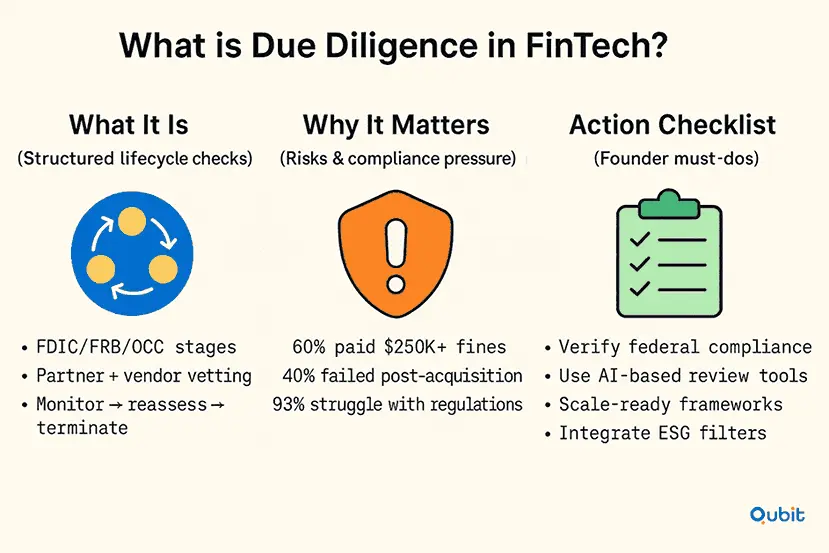Starting a FinTech venture is an exciting journey, but it comes with unique challenges that demand meticulous preparation. One critical step is conducting thorough due diligence to ensure your startup is investor-ready and compliant with industry standards. This checklist serves as a roadmap for founders to evaluate key aspects of their business, from financial modeling to regulatory compliance.
The guide further illustrates quantitative analysis by referencing fintech financial model investors, which demonstrates how careful financial modeling supports transparent investor evaluations. By addressing these foundational elements, FinTech founders can build trust with stakeholders and position their startups for sustainable growth.
Let’s dive into the essentials that every FinTech founder should prioritize during the due diligence process.
What is Due Diligence in Fintech Sector?

Due diligence in the FinTech sector is the systematic process of evaluating and monitoring all aspects of a potential partner, vendor, or technology before and after entering into a relationship.
It’s a critical subset of third-party risk management, structured around the life cycle stages defined by the FDIC, Federal Reserve, and OCC: planning, due diligence and third-party selection, contract negotiation, ongoing monitoring, and termination.
Because FinTech partnerships evolve rapidly, due diligence must be continuous: periodic reassessments, benchmarking performance against agreed-upon service-level metrics, and updating risk profiles whenever regulations or business models change.
The interagency guidance stresses that organizations should “leverage specialized expertise” and adopt a risk-based approach, prioritizing deeper reviews for higher-risk relationships and lighter touch for low-risk services. While maintaining clear documentation and board-level reporting throughout the partnership lifecycle
Why Due Diligence Matters for Fintech Startup?
The consequences of inadequate due diligence can be severe. For instance, 60% of fintech companies paid at least $250k in compliance fines last year, primarily due to insufficient transaction monitoring and customer due diligence. Additionally, 40% of acquired fintechs failed or were sold post-acquisition between 2014 and 2020, highlighting the risks of flawed evaluation processes.
Expert Insights
Industry experts like Lila Osman and Dr. Eleanor McKinney stress the importance of continuous due diligence, particularly in benchmarking against market standards. Their insights align with findings that 93% of fintechs find regulatory compliance challenging, underscoring the need for robust verification mechanisms.
Actionable Checklist for FinTech Founders
To streamline the due diligence process, founders should focus on the following:
- Compliance Verification: Ensure adherence to FDIC, Federal Reserve, and OCC guidelines.
- Risk Assessment: Incorporate tools like AI-powered due diligence automation, which reduces manual review time by 30% while improving risk detection accuracy.
- Scalability: Develop frameworks that accommodate the projected growth of the fintech market, expected to reach $1.15T by 2032.
- ESG Integration: Include environmental, social, and governance factors in evaluations, as 79% of institutional investors now consider ESG criteria.
For a complementary perspective on how to present these strategies effectively, explore fintech pitch deck essentials, which highlights the role of targeted presentation in fundraising preparation.
Due Diligence Framework for FinTech Partnerships
This section outlines the key elements you need to assess when evaluating potential fintech partners, from financial health to cybersecurity standards.
Key Due Diligence Elements
Community banks and fintech companies must evaluate six core areas under the FDIC’s Managing Third-Party Risk guidance:
- Financial Stability – Review audited financial statements, capitalization levels, and business continuity plans to confirm the partner can withstand market volatility.
- Operational Resilience – Assess uptime guarantees, disaster-recovery processes, and service-level performance against agreed benchmarks.
- Regulatory Compliance – Verify adherence to anti-money-laundering rules, data-privacy laws (GDPR or CCPA), sector-specific licensing, and reporting requirements.
- Cybersecurity and Data Privacy – Test for PCI-DSS or ISO 27001 certification, incident-response protocols, and encryption standards protecting customer data.
- Third-Party Controls – Examine how your partner oversees subcontractors, manages change controls, and enforces contractual audit rights.
- Ongoing Monitoring – Define periodic reassessment intervals, update risk ratings when regulations or business models change, and document every review step.
Audience and Distribution Strategy
Distribute this guide exclusively to FDIC-supervised institutions using secure, regulated channels:
• Secure digital portals where compliance teams can download and integrate the six topics into their standard operating procedures.
• FDIC regulatory bulletins that ensure alignment with supervisory expectations.
• Targeted email campaigns to risk-management distribution lists, accompanied by a one-page summary for quick reference.
Stakeholder Routing and Communication
Ensure accountability and adoption by routing the guide through these executive roles:
• CEO and Board of Directors for strategic endorsement and oversight.
• Chief Risk Officer and Compliance Officer for detailed policy review and updates.
• CIO/CTO for technical validation and integration planning.
Use executive briefings, secure intranet postings, and quarterly board materials to keep each stakeholder informed of their responsibilities.
The discussion is enriched by insights from fintech fundraising strategies and opportunities, which provide you with a broad context linking detailed due diligence to wider market trends. This connection highlights how routing the guide effectively can support executives in navigating both compliance requirements and growth opportunities.
Additional Due Diligence Areas for FinTech Startups
Legal and Corporate Structure Review
Every investor will ask to see clean paperwork before writing a single check. Start by confirming that your articles of incorporation or LLC operating agreement exactly match your ownership intentions—no stray share classes or undocumented founders.
Check that your stock-option plan is properly executed, with vesting schedules clearly defined. For example, if your CTO holds 10 percent in unvested options, investors will want to see the grant notices and vesting tracker. Finally, ensure all core intellectual property. A common pitfall is unfinished inventor assignments, which can derail term-sheet negotiations.
Market and Competitive Analysis
Beyond due diligence on your own books, investors want to know you understand the battlefield. Build a concise landscape map that shows total addressable market size (for instance, $12 billion in cross-border remittances), top incumbents (such as TransferWise and WorldRemit), and three emerging challengers.
Describe your unique edge, say, a machine-learning fraud filter that cuts chargeback losses by 40 percent and explain how your regulatory approvals (e.g., an EMV-certified card-issuing license) give you a moat. Including a mini heat-map of where competitors are strongest (e.g., consumer vs. SME use cases) makes your argument tangible.
Technology Architecture and Scalability
Illustrate your tech stack with a simple diagram, API gateway, microservices cluster, data-lake ingestion, analytics engine and point out your cloud-provider failover strategy. Explain how you’ll handle a ten-fold increase in daily transactions: perhaps by auto-scaling your Kubernetes pods and partitioning your database shards.
If you’ve stress-tested a 1 000 TPS scenario in a staging region and maintained 99.9 percent uptime, mention those results. Detail your encryption-at-rest policy (AES-256) and DDoS mitigation plan, so banks know you can scale securely.
Customer and User-Due Diligence
Nothing beats real traction when you’re on the hot seat. Share signed pilot agreements, such as the recent letter of intent from a 200-branch credit union and any paid-proof-of-concept metrics, like 15 000 transactions processed in your beta.
Walk through your KYC process: how long does on-boarding take (48 hours average), what data sources you query (e.g., LexisNexis, Experian), and how you monitor ongoing customer risk. If you maintain a 0.01 percent fraud rate among live users, spotlight that number to underscore your robustness.
Exit Strategy and Investor Alignment
Even early-stage founders should think like later-stage CEOs. Outline two plausible exits, say, acquisition by a large payments network at a 5× revenue multiple, or an IPO on a digital-asset exchange.
Show that your cap table accommodates both scenarios: no crushing liquidation preferences, reserved option pools, and a board seat structure that will satisfy strategic acquirers. If you’ve already had preliminary buy-side interest (for example, an NDA signed with a regional bank), note that to signal credibility.
Governance and Reporting Cadence
Define your board and advisory-board makeup: independent directors with banking backgrounds, a compliance lawyer, and an AI-security expert.
Set a clear reporting rhythm, weekly KPI dashboards tracking transaction volume and error rates, monthly burn-rate reviews, and quarterly strategic deep dives with metrics like customer lifetime value and net-promoter score. Explain how you’ll escalate material events (e.g., a cloud-outage incident report within four hours), so investors know you treat transparency as non-negotiable.
Stress-Testing and Scenario Planning
Finally, demonstrate you can survive even the worst storms. Describe your tabletop exercises, simulating a sudden 60 percent drop in funding, a major regulatory shift (like new PSD3 drafting), or a critical data-breach scenario and your trigger-based playbooks.
For example, if revenue dips 20 percent month-over-month, you’ll immediately enact a 10 percent cost-cutting protocol and open a $1 million bridge facility. Including a one-page summary of these drills reassures investors that you’re not just sailing in calm waters but are battle-ready if rough seas hit.
Conclusion
A well-executed due diligence process is essential for mitigating compliance risks and operational challenges. By following the strategies and checklist highlights discussed, you can ensure a smoother path toward securing investor trust and meeting regulatory requirements. This process not only safeguards your business but also positions it for long-term success.
We encourage you to apply these insights to strengthen your approach and enhance your preparedness for funding opportunities. If you’re looking for tailored support, our Fundraising Assistance team is here to help. Let us guide you through a comprehensive due diligence process that sets the stage for successful funding.
Key Takeaways
- A comprehensive due diligence checklist is crucial for FinTech founders.
- Regulatory guidance from the FDIC, Federal Reserve, and OCC informs best practices.
- Expert insights emphasize the necessity of continuous, market-driven due diligence.
- Real-world case studies and statistics highlight the risks and importance of mitigation.
- Effective routing ensures the guide reaches key decision-makers in fintech
Frequently asked Questions
What is due diligence in fintech?
Due diligence in fintech involves a comprehensive evaluation of a company’s regulatory compliance, risk management practices, and operational readiness. This process helps identify potential financial and legal pitfalls that could impact business stability.


 Back
Back



